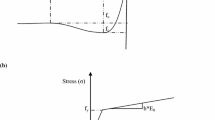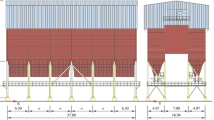Abstract
An important consideration for the adoption of stochastic ground motion models in performance-based earthquake engineering applications is that the probability distribution of target intensity measures from the developed suites of time-histories is compatible with the prescribed hazard at the site and structure of interest. The authors have recently developed a computationally efficient framework to modify existing stochastic ground motion models to facilitate such a compatibility. This paper extends this effort through a validation study by comparing the seismic demand of recorded ground motions to the demand of stochastic ground motion models established through the proposed modification. Suites of recorded and stochastic ground motions, whose spectral acceleration statistics match the mean and variance of target spectra within a period range of interest, are utilized as input to perform response history analysis of inelastic single-degree-of-freedom (SDoF) case-study systems. SDoF systems with peak-oriented hysteretic behavior, strain hardening, and (potentially) degrading characteristics, experiencing different degree of inelastic response, are considered. Response is evaluated using the peak inelastic displacement and the hysteretic energy given by the work of the SDoF restoring force as engineering demand parameters (EDPs). The resultant EDP distributions are compared to assess the effect of (and validate) the proposed modification. It is shown that the proposed modification of stochastic ground motion models can provide results that are similar to these from recorded ground motion suites, improving any (in some cases large) discrepancies that exist for the initial, unmodified stochastic ground motion model.





















Similar content being viewed by others
References
Abrahamson N, Atkinson G, Boore D, Bozorgnia Y, Campbell K, Chiou B, Idriss IM, Silva W, Youngs R (2008) Comparisons of the NGA ground-motion relations. Earthq Spectra 24(1):45–66
Anderson JG (2014) The composite source model for broadband simulations of strong ground motions. Seismol Res Lett 86(1):68–74
ASCE (2010) Minimum Design Loads for Buildings and Other Structures, ASCE 7-10. American Society of Civil Engineers (ASCE), Reston, Virginia
ASCE (2016) Minimum design loads for buildings and other structures, ASCE 7-16 ASCE, Reston, Virginia
Atkinson GM, Silva W (2000) Stochastic modeling of California ground motions. Bull Seismol Soc Am 90(2):255–274
Beck JL, Papadimitriou C (1993) Moving resonance in nonlinear response to fully nonstationary stochastic ground motion. Probab Eng Mech 8(3–4):157–167. https://doi.org/10.1016/0266-8920(93)90011-J
Boore DM (2003) Simulation of ground motion using the stochastic method. Pure Appl Geophys 160:635–676
Bradley BA (2010) A generalized conditional intensity measure approach and holistic ground-motion selection. Earthq Eng Struct Dyn 39(12):1321–1342
CEN (2004) Eurocode 8: design provisions for earthquake resistance of structures, part 1.1: general rules, seismic actions and rules for buildings. Pren1998-1
Chiou B, Darragh R, Gregor N, Silva W (2008) NGA project strong-motion database. Earthq Spectra 24(1):23–44
Deniz D, Song J, Hajjar JF (2017) Energy-based seismic collapse criterion for ductile planar structural frames. Eng Struct 141:1–13
FEMA-P-58 (2012) Seismic performance assessment of buildings. Applied Technology Council, Redwood City
Galasso C, Iervolino I (2011) Relevant and minor criteria in real record selection procedures based on spectral compatibility. In: Proceedings of the 14th conference ANIDIS “L’ingegneria sismica in Italia”, Bari (Italy)
Galasso C, Zareian F, Iervolino I, Graves R (2012) Validation of ground-motion simulations for historical events using SDoF systems. Bull Seismol Soc Am 102(6):2727–2740
Gidaris I, Taflanidis AA (2013) Parsimonious modeling of hysteretic structural response in earthquake engineering: calibration/validation and implementation in probabilistic risk assessment. Eng Struct 49:1017–1033
Gidaris I, Taflanidis AA (2015) Performance assessment and optimization of fluid viscous dampers through life-cycle cost criteria and comparison to alternative design approaches. Bull Earthq Eng 13(4):1003–1028
Goulet CA, Haselton CB, Mitrani-Reiser J, Beck JL, Deierlein G, Porter KA, Stewart JP (2007) Evaluation of the seismic performance of code-conforming reinforced-concrete frame building-From seismic hazard to collapse safety and economic losses. Earthq Eng Struct Dyn 36(13):1973–1997
Graves RW, Pitarka A (2010) Broadband ground-motion simulation using a hybrid approach. Bull Seismol Soc Am 100(5A):2095–2123
Graves R, Jordan TH, Callaghan S, Deelman E, Field E, Juve G, Kesselman C, Maechling P, Mehta G, Milner K (2011) CyberShake: a physics-based seismic hazard model for southern California. Pure Appl Geophys 168(3–4):367–381
Iervolino I, De Luca F, Cosenza E (2010a) Spectral shape-based assessment of SDOF nonlinear response to real, adjusted and artificial accelerograms. Eng Struct 32(9):2776–2792
Iervolino I, Galasso C, Cosenza E (2010b) REXEL: computer aided record selection for code-based seismic structural analysis. Bull Earthq Eng 8(2):339–362
Kaklamanos J, Baise LG, Boore DM (2011) Estimating unknown input parameters when implementing the NGA ground-motion prediction equations in engineering practice. Earthq Spectra 27(4):1219–1235
Katsanos E, Sextos A (2015) Inelastic spectra to predict period elongation of structures under earthquake loading. Earthq Eng Struct Dyn 44(11):1765–1782
Katsanos E, Sextos A (2018) Structure-specific selection of earthquake ground motions for the reliable design and assessment of structures. Bull Earthq Eng 16(2):583–611
Katsanos EI, Sextos AG, Manolis GD (2010) Selection of earthquake ground motion records: a state-of-the-art review from a structural engineering perspective. Soil Dyn Earthq Eng 30(4):157–169
Kohrangi M, Bazzurro P, Vamvatsikos D, Spillatura A (2017) Conditional spectrum‐based ground motion record selection using average spectral acceleration. Earthq Eng Struct Dyn
Lin T, Haselton CB, Baker JW (2013) Conditional spectrum-based ground motion selection. Part I: Hazard consistency for risk-based assessments. Earthq Eng Struct Dyn 42(12):1847–1865
Mathworks (2018) SIMULINK: User’s Guide
Mavroeidis GP, Scotti CM (2013) Finite-fault simulation of strong ground motion from the 2010 M w 7.0 Haiti earthquake. Bull Seismol Soc Am 103(5):2557–2576
Moehle J, Deierlein G (2004) A framework methodology for performance-based earthquake engineering. In: 13th World conference on earthquake engineering, Vancouver, Canada, August 1–6
Power M, Chiou B, Abrahamson N, Bozorgnia Y, Shantz T, Roblee C (2008) An overview of the NGA project. Earthq Spectra 24(1):3–21
Reyes JC, Kalkan E (2012) How many records should be used in an ASCE/SEI-7 ground motion scaling procedure? Earthq Spectra 28(3):1223–1242
Rezaeian S, Der Kiureghian A (2010) Simulation of synthetic ground motions for specified earthquake and site characteristics. Earthq Eng Struct Dyn 39(10):1155–1180
Ruiz-García J, Miranda E (2003) Inelastic displacement ratios for evaluation of existing structures. Earthq Eng Struct Dyn 32(8):1237–1258
Scherbaum F, Cotton F, Staedtke H (2006) The estimation of minimum-misfit stochastic models from empirical ground-motion prediction equations. Bull Seismol Soc Am 96(2):427–445
Seifried A, Baker J (2016) Spectral variability and its relationship to structural response estimated from scaled and spectrum-matched ground motions. Earthq Spectra 32(4):2191–2205
Smerzini C, Galasso C, Iervolino I, Paolucci R (2014) Ground motion record selection based on broadband spectral compatibility. Earthq Spectra 30(4):1427–1448
Tsioulou A, Taflanidis AA, Galasso C (2018a) Modification of stochastic ground motion models for matching target intensity measures. Earthq Eng Struct Dyn 47(1):3–24
Tsioulou A, Taflanidis AA, Galasso C (2018b) Hazard-compatible modification of stochastic ground motion models. Earthq Eng Struct Dyn 47(8):1774–1798
Vetter C, Taflanidis A (2014) Comparison of alternative stochastic ground motion models for seismic risk characterization. Soil Dyn Earthq Eng 58:48–65
Vetter C, Taflanidis AA, Mavroeidis GP (2016) Tuning of stochastic ground motion models for compatibility with ground motion prediction equations. Earthq Eng Struct Dyn 45(6):893–912
Vlachos C, Papakonstantinou KG, Deodatis G (2018) Predictive model for site specific simulation of ground motions based on earthquake scenarios. Earthq Eng Struct Dyn 47(1):195–218
Author information
Authors and Affiliations
Corresponding author
Additional information
Publisher's Note
Springer Nature remains neutral with regard to jurisdictional claims in published maps and institutional affiliations.
Electronic supplementary material
Below is the link to the electronic supplementary material.
Appendix 1: Details for the stochastic ground motion modification framework
Appendix 1: Details for the stochastic ground motion modification framework
The statistical characterization pg(ln(Sa(Ti))|μ,Σ) for IM Sa(Ti) through the stochastic ground motion model can be obtained by propagating the uncertainty originating from the predictive relationship p(θ|μ,Σ) for the model parameter vector θ and the stochastic sequence involved in the model description, denoted w herein. Following Tsioulou et al. (2018b) the statistical characterization for the log IM, ln(Sa(Ti)), is approximated as Gaussian with mean and variance:
where p(w) is the probability distribution for the stochastic sequence w and \(S_{a}^{g} (T_{i} ,{\varvec{\uptheta}},{\mathbf{w}})\) denotes the estimate for Sa(Ti) established through the stochastic ground motion model for specific values of the model parameter vector θ and a specific white-noise sequence w [i.e. for a specific ground motion time-history provided through the model]. Equations (2) and (3) ultimately represent the uncertainty propagation (from θ and w) to estimate the probability distribution for Sa(Ti), in this case approximated as a lognormal distribution.
The hazard compatible modification of the probability model for θ, ultimately of the parametric description defined through μ and Σ, is formulated as a multi-objective optimization problem
As discussed in Sect. 2, the first objective F1 is the discrepancy between the target and predicted hazard probabilistic descriptions, quantified through the relative entropy as (Tsioulou et al. 2018b)
where the integral corresponds to the relative entropy of the compared distributions and γi represent the weights prioritizing the match to different IM components (spectral accelerations at different structural periods), taken in this study all equal to 1. For the typical case, which is the one examined in this paper, that pt(ln(Sa(Ti))|z) corresponds also to a Gaussian description for ln(Sa(Ti)) with mean \(\ln (\bar{S}_{a} (T_{i} ,{\mathbf{z}}))\) and variance \(\sigma^{2} (T_{i} ,{\mathbf{z}})\), F1 in (6) has closed-form solution
Objective F2 is quantified by the entropy between the original probability model p(θ|μr(z),Σr), and the modified one, p(θ|μ,Σ)
where tr[.] and det[.] stand for trace and determinant, respectively, and nθ corresponds to the dimension of the θ vector.
The Pareto set corresponding to the multi-objective optimization problem of Eq. (4) can be identified through any standard numerical approach, for example through genetic algorithms or stochastic search, provided that the two objectives F1 and F2 can be efficiently estimated. For objective F1 this represents a challenge, since its estimation involves the high-dimensional integrals described by Eqs. (2) and (3). A framework relying on surrogate modelling was established in Tsioulou et al. (2018b) to facilitate a computational efficient implementation. Foundation of the framework is the development of a surrogate model approximation for the conditional on θ statistics, with total statistics [corresponding ultimately to Eqs. (2) and (3)] calculated through Monte Carlo integration leveraging the computational efficiency of the aforementioned surrogate model. Though computational burden for development of the surrogate model is considerable, this is a one-time cost; once the surrogate model is developed it can be implemented to support an efficient identification of the Pareto front of Eq. (4) for any desired scenario z.
Beyond the ground motion modification framework that established hazard-compatibility, a simplified implementation also exists (Tsioulou et al. 2018a) that focuses only on compatibility for the mean IM, completely ignoring variability in the predictive relationships and ultimately representing p(θ|μ,Σ) simply by μ (i.e., assumes Σ = 0). This means that the average IM prediction in Eq. (2) simplifies to
since only source of variability is w, while the variance \(\sigma^{g} (T_{i} ,{\varvec{\upmu}})\) cannot be directly controlled (only contributing factor is w) and therefore is ignored. The ground motion modification in this case focuses simply on matching the mean IM and corresponds to adjustment of objectives F1 and F2, respectively, to
The identification of the Pareto front in this case is based on a similar surrogate modeling approximation and it is implemented with even higher computational efficiency (Tsioulou et al. 2018a), since estimation of F1 involves no Monte Carlo integration step (no uncertainty to address with respect to θ).
Rights and permissions
About this article
Cite this article
Tsioulou, A., Taflanidis, A.A. & Galasso, C. Validation of stochastic ground motion model modification by comparison to seismic demand of recorded ground motions. Bull Earthquake Eng 17, 2871–2898 (2019). https://doi.org/10.1007/s10518-019-00571-x
Received:
Accepted:
Published:
Issue Date:
DOI: https://doi.org/10.1007/s10518-019-00571-x




